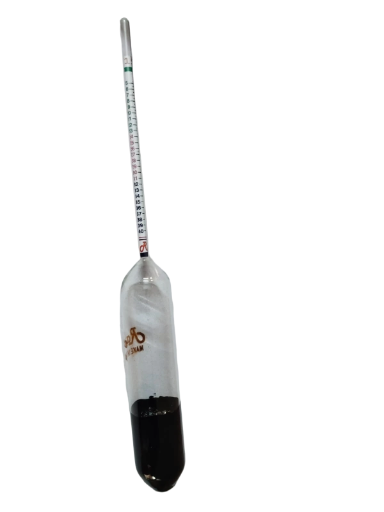
Glass lactometer 0-40%
Glass lactometer 0-40%
₹55.00₹35.00
A glass lactometer is an essential tool used primarily in the dairy industry to measure the density of milk, which helps determine its quality and fat content. Specifically calibrated to function within a range of 0-40%, this instrument provides dairy producers with a straightforward method to assess milk's purity and composition, ensuring compliance with health standards and optimizing production. ### What is a Glass Lactometer? A lactometer is a hydrometer that is designed for the dairy sector. It operates on the principle of buoyancy; when placed in a sample of milk, the lactometer will float to a certain level, indicating the density of the liquid. The glass lactometer is typically made from high-quality, durable glass that allows for easy reading of the scale and resists staining from milk proteins or fats. ### How Does It Work? To use the glass lactometer effectively, the process begins by carefully pouring a sample of milk into a clean, clear container. It’s important that the container is tall enough so that there is ample space for the lactometer to float. Once the sample is poured, the glass lactometer is gently lowered into the milk. After ensuring that the lactometer is not touching the sides of the container, the user will observe where the surface of the milk intersects with the scale on the lactometer. The precise level indicated on the scale will let the user know the density of the milk, measured in terms of specific gravity. This measurement provides vital information about the amount of solid content in the milk, which includes proteins, lactose, and fats. ### Importance of Lactometer Readings The reading obtained from the glass lactometer is crucial for several reasons: 1. **Quality Control**: Producers can quickly verify the quality of milk. A lower density than expected could indicate adulteration or dilution with water, while a higher density may suggest a richer fat content, which can be beneficial or potentially harmful depending on market specifications. 2. **Standardization**: For dairy producers aiming to meet regulatory standards, maintaining certain density levels is essential. Regular measurement using a lactometer helps ensure compliance with local and international food safety standards. 3. **Product Consistency**: For manufacturers of dairy products, consistent milk quality is key. By closely monitoring milk density, they can adjust production processes or source from different suppliers if levels fluctuate significantly. ### Calibration and Maintenance A glass lactometer must be properly calibrated to ensure accurate readings. Typically, calibration is conducted against known standards. Users should frequently check the calibration of their lactometer, especially if it has been dropped or exposed to extreme conditions. Maintenance of the lactometer involves regular cleaning and storage. After each use, it is essential to rinse the lactometer with warm water and a mild detergent to remove any residues. It should be stored upright in a protective case to prevent breakage or any potential contamination. ### Conclusion In conclusion, the glass lactometer is a vital instrument in the dairy industry, allowing producers to efficiently monitor milk quality within the critical range of 0-40%. Its ease of use, along with the significant insights it provides into milk composition, makes it an indispensable tool for ensuring high-quality dairy products. As the dairy sector continues to adapt to evolving consumer demands and regulatory environments, the glass lactometer stands out as a reliable and accurate method for quality assessment.
